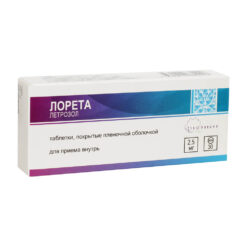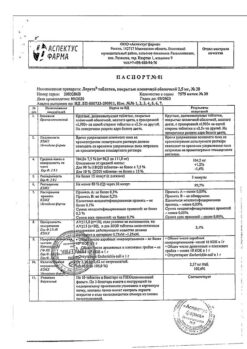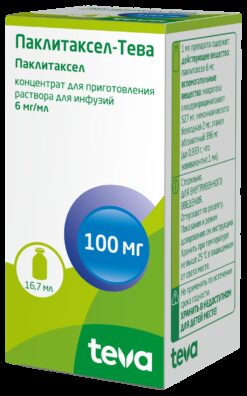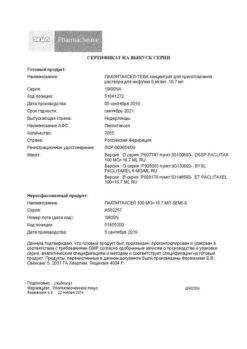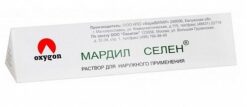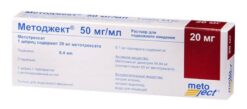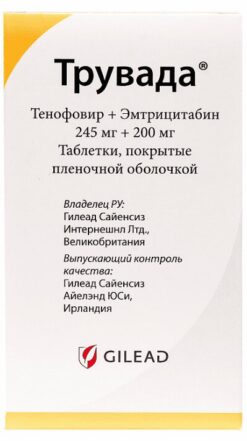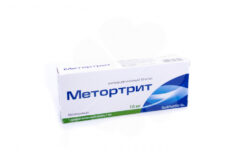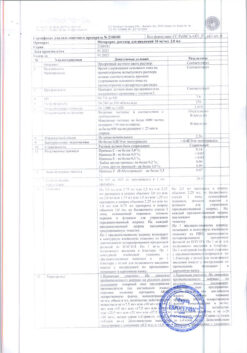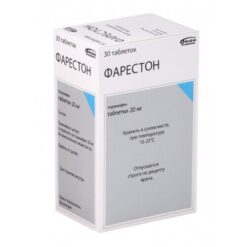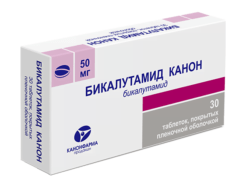No products in the cart.
Description
Pharmacodynamics
The gonadotropin-releasing hormone analogue is a depo-form. Leuprorelin is a synthetic non-peptide analogue of natural GnRH which, with long-term use, inhibits pituitary gonadotropin secretion and suppresses testicular steroidogenesis in men. The analog is more effective than the natural hormone and its effects are reversible when treatment is discontinued. Leuprorelin administration initially leads to increased levels of circulating LH and FSH, resulting in a temporary increase in male gonadal steroids, testosterone, and dihydrotestosterone. With prolonged use of leuprorelin, LH and FSH levels decrease. In men, testosterone levels decrease to castration levels (≤50 ng/dL) within 3-5 weeks after starting treatment. Mean testosterone levels after 6 months of treatment are 6.1 (±0.4) ng/dL for the 7.5 mg dose; 10.1 (±0.7) ng/dL for the 22.5 mg dose and 10.4 (±0.53) ng/dL for the 45 mg dose. These values are comparable to testosterone levels after bilateral orchiectomy.
Pharmacokinetics
Intake Distribution
After the first injection, after 4-8 h the mean leuprorelin concentration level (Cmax) determined in serum increases to 25.3 ng/dL, 127 ng/dL, and 82 ng/dL when leuprorelin doses of 7.5 mg, 22.5 mg, and 45 mg are used, respectively. After an initial increase (plateau phase is 2 to 28 days for 7.5 mg doses; 3 to 84 days for 22.5 mg doses; 3 to 168 days for 45 mg doses), serum leuprorelin levels remained relatively stable (0.2 to 2 ng/mL). No data were available on the accumulation of the substance with repeated injections.
The binding to plasma proteins is 43-49%.
Elevation
In administration of 1 mg of leuprorelin acetate by IV to healthy male volunteers, it was found that using a dual-chamber model, mean clearance was 8.34 L/h with a final T1/2 of approximately 3 h. No studies of elimination of Eligard have been performed.
Indications
Indications
Hormone-dependent prostate cancer.
Pharmacological effect
Pharmacological effect
Pharmacodynamics
Gonadotropin-releasing hormone analogue – depot form. Leuprorelin is a synthetic non-peptide analogue of natural GnRH, which, with long-term use, inhibits the secretion of pituitary gonadotropin and suppresses testicular steroidogenesis in men. The analogue is more effective than the natural hormone and its effect is reversible upon cessation of treatment. Administration of leuprorelin initially increases circulating levels of LH and FSH, resulting in a transient increase in gonadal steroids, testosterone, and dihydrotestosterone in men. With prolonged use of leuprorelin, the levels of LH and FSH decrease. In men, testosterone levels decrease to castration levels (≤50 ng/dL) within 3-5 weeks after initiation of treatment. The average testosterone level after 6 months of treatment is 6.1 (±0.4) ng/dL for a dosage of 7.5 mg; 10.1 (±0.7) ng/dL for the 22.5 mg dosage and 10.4 (±0.53) ng/dL for the 45 mg dosage. These values are comparable to testosterone levels after bilateral orchiectomy.
Pharmacokinetics
Suction distribution
After the first injection, after 4-8 hours, the average level of leuprorelin concentration (Cmax) determined in the blood serum increases to 25.3 ng/dL, 127 ng/dL and 82 ng/dL when using leuprorelin at a dose of 7.5 mg, 22.5 mg and 45 mg, respectively. After the initial increase (plateau phase of 2 to 28 days for the 7.5 mg dosage; 3 to 84 days for the 22.5 mg dosage; 3 to 168 days for the 45 mg dosage), serum leuprorelin levels remained relatively stable (0.2 to 2 ng/mL). There are no data on the accumulation of the substance with repeated injections.
Plasma protein binding – 43-49%.
Removal
When 1 mg of leuprorelin acetate was administered intravenously to healthy male volunteers, it was found that using a two-chamber model, the average clearance was 8.34 l/h with a final half-life of approximately 3 hours. Eligard elimination studies have not been conducted.
Special instructions
Special instructions
Eligard should be used under the supervision of a physician experienced in the use of antitumor therapy.
Eligard, like other GnRH agonists, during the first week of treatment causes a short-term increase in the concentration of testosterone, dihydrotestosterone and acid phosphatase in the blood serum, and therefore, patients may experience increased symptoms or new ones, such as bone pain, neurological disorders, hematuria, ureteral obstruction or bladder outlet obstruction. These symptoms usually resolve with continued therapy. Cases of spinal cord compression have also been reported with the use of GnRH agonists. If necessary, standard treatment for these complications should be carried out.
Patients with metastases to the spine and/or brain, as well as patients with urinary tract obstruction, should be closely monitored during the first few weeks of treatment.
Additional administration of an appropriate antiandrogen 3 days before the start of Eligard therapy and continued use during the first two or three weeks of treatment prevents the consequences of the initial increase in testosterone levels.
Antiandrogen therapy increases the risk of bone fractures due to osteoporosis. In addition to long-term testosterone deficiency, the development of osteoporosis can be influenced by advanced age, smoking, alcohol consumption, excess body weight and insufficient exercise.
Due to a possible decrease in glucose tolerance, patients with diabetes mellitus require more careful monitoring when treated with Eligard.
After surgical castration, the use of Eligard does not lead to a further decrease in serum testosterone.
Impact on the ability to drive vehicles and other mechanisms that require increased concentration
Some adverse reactions of the drug, such as increased fatigue, dizziness, visual disturbances, may negatively affect the ability to drive a car and perform potentially dangerous activities that require increased concentration and speed of psychomotor reactions.
Active ingredient
Active ingredient
Leuprorelin
Composition
Composition
1 dose (1 syringe (B)) contains:
Active substances:
leuprorelin acetate 7.5 mg (10.6 mg)*.
Solvent (syringe A):
poly-D copolymer,
L-lactide-co-glycolide:PLGC (50:50) – 117 mg,
N-methyl-2-pyrrolidone – 226 mg.
* – the drug contains an excess of the active substance to compensate for losses in the syringe and needle.
There are 2 syringes in a cell package.
In a cardboard package there are 2 cell packs.
Contraindications
Contraindications
Surgical castration;
hypersensitivity to leuprorelin, other GnRH agonists or to any excipient included in the dosage form;
Contraindicated for women and children.
Side Effects
Side Effects
Side effects observed with the use of Eligard are mainly due to the pharmacological action of the drug.
From the cardiovascular system: hot flashes, increased or decreased blood pressure, fainting; in some cases – peripheral edema, embolism of the branches of the pulmonary artery, palpitations, shortness of breath.
From the central nervous system and peripheral nervous system: hypoesthesia, dizziness, headache, insomnia, taste disorders, smell disorders, involuntary movements; in some cases – sleep disturbances, depression, peripheral dizziness, amnesia, visual disturbances and increased skin sensitivity.
From the digestive system: nausea/vomiting, diarrhea, dyspepsia, constipation, dry mouth, belching, flatulence, increased ALT.
From the respiratory system: rhinorrhea, difficulty breathing.
From the genitourinary system: dysuria, nocturia, oliguria, urinary tract infection, difficulty urinating, bladder spasms, hematuria, acute urinary retention, testicular atrophy, testicular pain, infertility, impotence, decreased libido.
From the endocrine system: pain in the mammary glands, gynecomastia.
From the musculoskeletal system: arthralgia, back pain, pain in the extremities, myalgia, muscle cramps, muscle weakness.
Patients with surgical or medical castration experience a decrease in bone density. It should be borne in mind that long-term use of Eligard can also lead to a decrease in bone density and the progression of osteoporosis.
From the hematopoietic system: decrease in the number of red blood cells, hemoglobin levels and hematocrit; rarely – thrombocytopenia, leukopenia.
From the blood coagulation system: increased blood clotting time, increased prothrombin time.
From laboratory parameters: increased CPK content in the blood, increased triglycerides in the blood.
Local reactions: burning/tingling, pain, redness, bruising and itching at the injection site; rarely – compaction and ulceration at the injection site.
Other: feeling unwell, increased fatigue, weakness, skin rash, alopecia, increased sweating, chills, changes in glucose tolerance, weight gain. In the first weeks after starting Eligard therapy, an exacerbation of the symptoms of the disease may occur.
Interaction
Interaction
No studies have been conducted to study the pharmacokinetic interaction of Eligard with other drugs.
Eligard’s interactions with other drugs have not been reported.
Overdose
Overdose
There are no data regarding overdose in humans. In case of overdose, the patient should receive symptomatic treatment.
Storage conditions
Storage conditions
At 2–8 °C in original packaging
Shelf life
Shelf life
2 years
Manufacturer
Manufacturer
Tolmar Inc., USA
Additional information
| Shelf life | 2 years |
|---|---|
| Conditions of storage | At 2-8 °C in the original package |
| Manufacturer | Tolmar Inc. |
| Medication form | lyophilizate |
| Brand | #Н/Д |
Related products
Buy Eligard, lyophilizate 7.5 mg syringes 2 pcs with delivery to USA, UK, Europe and over 120 other countries.


